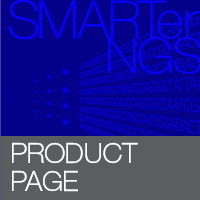Differential expression (DE) analysis focuses on comparing the relative expression levels of different transcripts in the cell and is one of the primary analysis tools used to explore transcriptome variability. End-capture methods are appealing for DE analysis as they can decrease the number of reads necessary to determine differential expression between cells. By focusing the sequencing data on a portion of each transcript (in this case, the 3' end of each transcript), we can reduce the number of reads and hence the overall cost required to identify expressed genes. Additionally, samples can be pooled prior to sequencing, decreasing the work and resources required and increasing the multiplexing capabilities of each sequencing lane.
In this tech note, we demonstrate the use of SMART-Seq v4 chemistry combined with an end-capture method for low-input amounts down to the single-cell level. As we have previously reported, SMART-Seq v4 technology produces high-quality cDNA libraries from individual cells that closely represent the original in vivo mRNAs. It is extremely sensitive, works with transcripts of different lengths, and has excellent gene body coverage across a wide range of GC content (see References for details). In order to reduce labor and cost, we have adapted this robust technology for 3' end capture, and here we present this approach and validate it by sequencing single K562 cells.
This approach allows each pool of cDNA from 12 single-cell reactions to be tagged by one of the 96 Illumina HT barcode combinations, enabling up to 1,152 separate cell reads per run. Researchers using this kit can confidently determine differentially expressed transcripts while decreasing the cost and time required for discovery. This method utilizes a modified oligo(dT) primer including an in-line index which serves as a cell barcode and a portion of the Illumina read primer 2 sequence in order to accommodate a pooled library generation protocol (Figure 1). The in-line index is placed between the transcript and the Illumina read primer 2 (RP2), and enables pooled cell samples to be demultiplexed after sequencing.

Figure 1. Overview of the end-capture method for analyzing differential expression. cDNA (black lines) is synthesized with a blocked (black star) and modified oligo(dT) primer that adds sequences for subsequent amplification and analysis—a cell barcode (magenta), part of the Illumina read primer 2 sequence (RP2, yellow), and the SMART IIA sequence (green). The SMART IIA sequence is used as a priming site during cDNA amplification, the Illumina RP2 sequence is used as a priming site during library amplification, and the cell barcode is used for demultiplexing pooled samples during analysis. The process works as follows: first, the template for SMARTScribe reverse transcriptase switches from the mRNA (blue wavy line) to the SMART-Seq v4 Oligonucleotide (green). After reverse transcription, the full-length cDNA is amplified by PCR with blocked Primer IIA oligonucleotides. After cDNA amplification, the presence of the barcode (magenta) allows for pooling up to 12 samples. The pooled samples are tagmented and Illumina Nextera® read primer 1 and 2 sequences are added by the Nextera Tn5 transposon (TnRP1 and TnRP2, orange and purple respectively). The 3' ends of the original mRNA are captured by selective PCR with primers for the TnRP1 and RP2 sequences. Other products of the transposon-based reaction are not amplified, either because there are no primer sites for amplification or because of suppression PCR. Cluster generation (pink and dark purple) and indexing sequences (light blue and dark blue) are added during this PCR stage to generate a library ready for sequencing on an Illumina platform.







